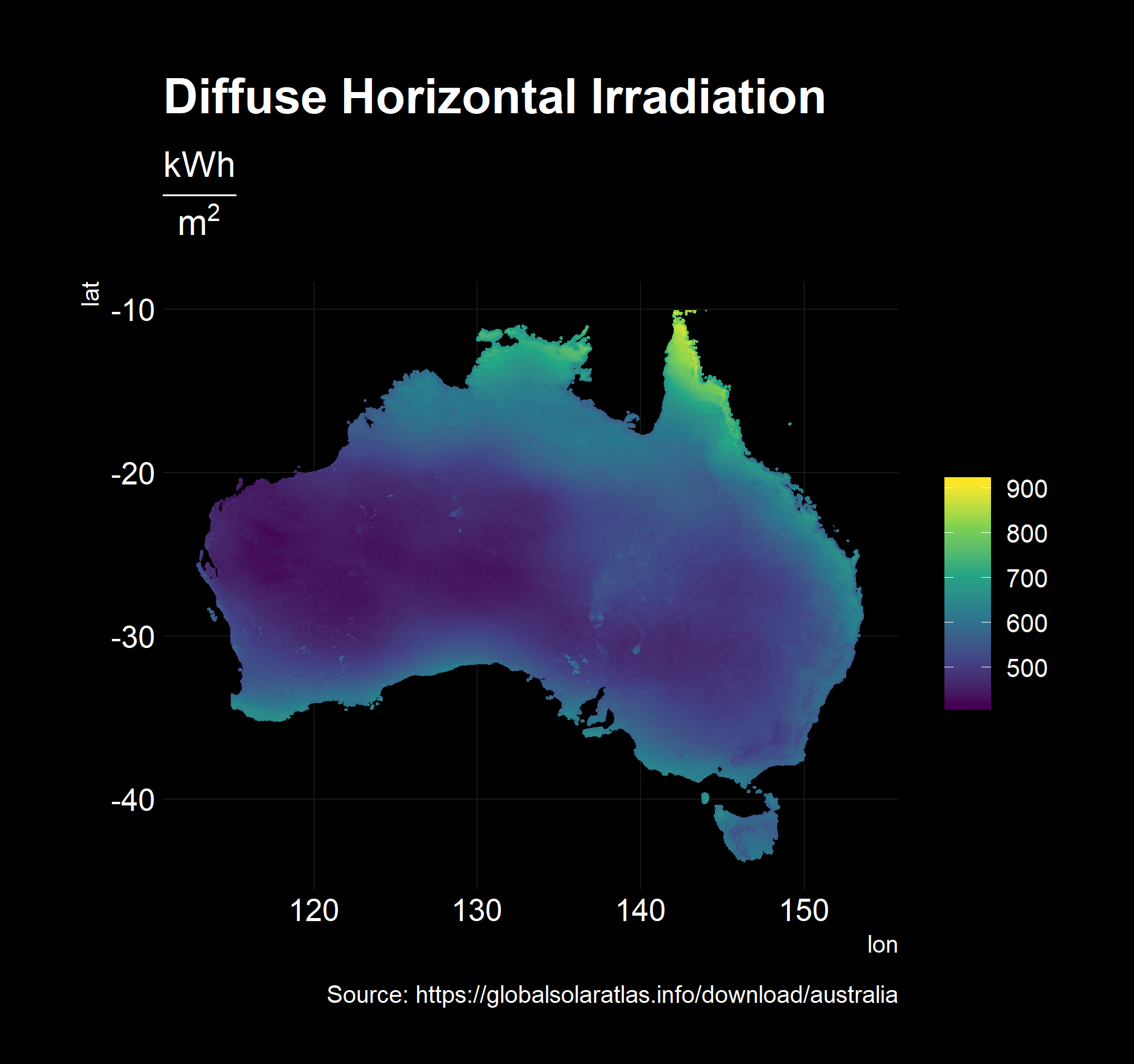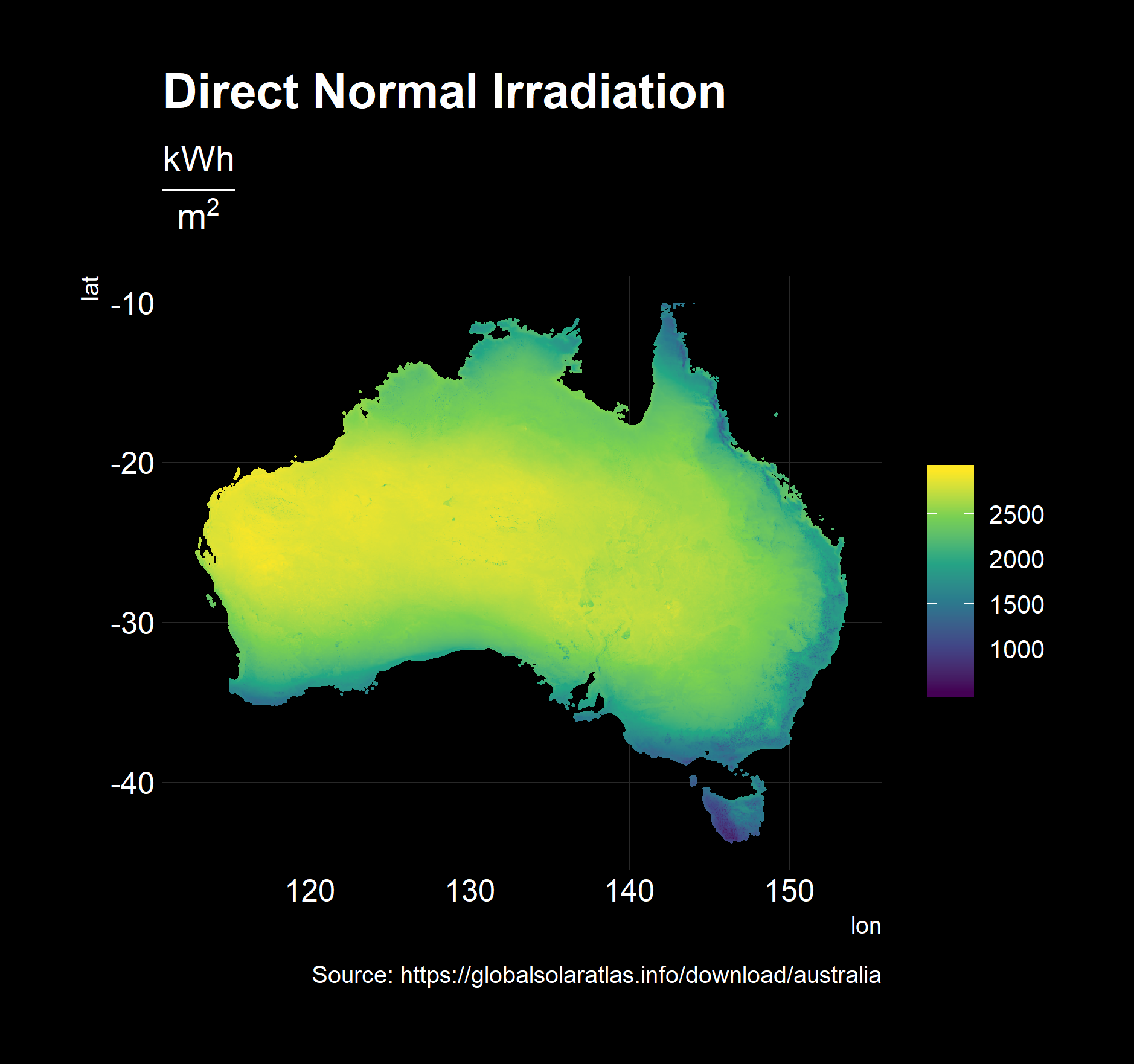Solar Data
In Part 01 of this series, Andrew Durkan identified that vines need around 1300 hours of sunshine, and as such, sunlight was going to be a significant factor. After some searching for sources, I settled on the outputs from the Global Solar Atlas. This resource doesn’t provide sunlight hours but instead has other measures, including:
- Specific photovoltaic power output
- Direct normal irradiation
- Global horizontal irradiation
- Diffuse horizontal irradiation
- Global irradiation for optimally tilted surface
I figured that this dataset — whilst not exactly what I was after — should be a strong covariant. I downloaded the Annual and monthly statistics where available.
pacman::p_load(tidyverse, curl, sf, glue)
#https://globalsolaratlas.info/download/australia
root = "input/05 solar"
file_name = "Australia_GISdata_LTAy_YearlyMonthlyTotals_GlobalSolarAtlas-v2_GEOTIFF"
zip_url = glue("https://api.globalsolaratlas.info/download/Australia/{file_name}.zip")
zip_path = glue("{root}/{file_name}.zip")
curl_download(zip_url, zip_path)
zip::unzip(zip_path, exdir = glue("{root}"))The zip file unpacked into the following file structure:
├─── 05 solar │ ├─── Australia_GISdata_LTAy_YearlyMonthlyTotals_GlobalSolarAtlas-v2_GEOTIFF │ │ └─── monthly
This data was in EPSG:4326 (WGS 84) at various resolutions, specifically:
- Solar resource data (GHI, DIF, GTI, DNI): 9 arcsecs ~ 250 m
- Specific Photovoltaic Power Output: 30 arcsecs ~ 1 km
- Optimal Tilt Angle: 120 arcsec ~ 4 km
The project so had a spatial resolution of 150 arcsecs ~ 4.6km, as determined by using the formulas below (Nominals radius of Earth at the equator of 6371 km).
Some interpolation will be required to compare these data sets directly. $GDAL$, ever faithful, has this functionality in the $translate$ function. From the documentation, I need to pass the $-tr$ option and the x and y resolutions in addition to the source and destination file paths.
The sf package has a handy helper function wrapped around $GDAL$’s native utilities sf::gdal_utils which will be the basis of the function I will map over the GeoTIFF files.
On inspection, however, I noticed a second issues:
> raster::raster("input/05 solar/Australia_GISdata_LTAy_YearlyMonthlyTotals_GlobalSolarAtlas-v2_GEOTIFF/DIF.tif" )
class : RasterLayer
dimensions : 14000, 19200, 268800000 (nrow, ncol, ncell)
resolution : 0.0025, 0.0025 (x, y)
extent : 112, 160, -44, -9 (xmin, xmax, ymin, ymax)
crs : +proj=longlat +datum=WGS84 +no_defs +ellps=WGS84 +towgs84=0,0,0
source : C:/Users/Mathew Merryweather/Documents/GitHub/wine_map/input/05 solar/Australia_GISdata_LTAy_YearlyMonthlyTotals_GlobalSolarAtlas-v2_GEOTIFF/DIF.tif
names : DIF
values : 383.147, 916.412 (min, max)Take a look at the extent compared to my projects:
"Source Raster"
extent : 112, 160, -44, -9 (xmin, xmax, ymin, ymax)
"Project"
extent : 112, 154, -44, -10 (xmin, xmax, ymin, ymax)I need to “crop” into the project and modify the extent as well. I used sf::gdal_utils again but this time passing the $-projwin$ arguments and my extent coordinates. Due to limitations under the hood, I couldn’t pipe the results from one call into the destination of another which would have been much more elegant. Instead, I dropped the first call to a TEMP file then input that into the second call. I wrapped both of these calls into a function for mapping.
gdal_resize = function(source, destination, res){
# https://gdal.org/programs/gdal_translate.html
# gdal_translate -tr 0.1 0.1 "C:\dem.tif" "C:\dem_0.1.tif"
sf::gdal_utils("translate",
source = source,
destination = str_replace(destination, "\\.tif","\\_temp\\.tif"),
options = c("-tr", res, res))
# gdal_translate -projwin ulx uly lrx lry inraster.tif outraster.tif`
sf::gdal_utils("translate",
source = str_replace(destination, "\\.tif","\\_temp\\.tif"),
destination = destination,
options = c("-projwin",
112,
-10,
154,
-44))
file.remove(str_replace(destination, "\\.tif","\\_temp\\.tif"))
destination
}I pilfered the raster to dataframe code from part #2; however, I simplified it for the single-band raster case.
singleband_raster_to_dataframe = function(img){
img_brick = img %>%
raster::raster() %>%
raster::brick()
col_name = img_brick@data@names[1]
img_brick@data@values %>%
as.data.frame() %>%
set_names(nm = str_to_lower(col_name))
}I wanted the code to be flexible enough to handle the monthly and annual case with minimal rewriting, so I included a directory check and creation step in the per folder function, leading to the following structure:
├─── 05 solar │ ├─── Australia_GISdata_LTAy_YearlyMonthlyTotals_GlobalSolarAtlas-v2_GEOTIFF │ │ └─── monthly │ └─── scaled │ ├─── annual │ └─── monthly
Additionally, the names (GHI, DIF, DNI) are not very friendly, and I’ll forget what they mean when I get to the modelling steps. To get around this, I also included a named replacement list for the destination files.
folder_of_tifs_to_df = function(input_folder, output_folder){
# Remove the TEMP Variable
input_folder %>% list.files(full.names = T, pattern = "TEMP") %>% file.remove()
files = input_folder %>%
list.files(pattern = "tif$",
full.names = T) %>%
sort()
if(!dir.exists(output_folder)){
dir.create(output_folder, showWarnings = F, recursive = T)
}
expand_names = c("PVOUT" = "photovoltaic_power_potential",
"GHI" = "global_horizontal_irradiation",
"DIF" = "diffuse_horizontal_irradiation",
"GTI" = "global_irradiation_for_optimally_tilted_surface",
"DNI" = "direct_normal_irradiation",
"OPTA" = "optimum_tilt_to_maximize_yearly_yield")
dest_files = input_folder %>%
list.files(pattern = "tif$") %>%
sort() %>%
str_c(output_folder,"/",.) %>%
str_replace_all(expand_names)
res = 360 / 8640
gdal_resize = function(source, destination, res){
# https://gdal.org/programs/gdal_translate.html
# gdal_translate -tr 0.1 0.1 "C:\dem.tif" "C:\dem_0.1.tif"
sf::gdal_utils("translate",
source = source,
destination = str_replace(destination, "\\.tif","\\_temp\\.tif"),
options = c("-tr", res, res))
# gdal_translate -projwin ulx uly lrx lry inraster.tif outraster.tif`
sf::gdal_utils("translate",
source = str_replace(destination, "\\.tif","\\_temp\\.tif"),
destination = destination,
options = c("-projwin",
112,
-10,
154,
-44))
file.remove(str_replace(destination, "\\.tif","\\_temp\\.tif"))
destination
}
singleband_raster_to_dataframe = function(img){
img_brick = img %>%
raster::raster() %>%
raster::brick()
col_name = img_brick@data@names[1]
img_brick@data@values %>%
as.data.frame() %>%
set_names(nm = str_to_lower(col_name))
}
df = files %>%
map2_chr(.y = dest_files,
.f = gdal_resize,
res = res) %>%
map_dfc(singleband_raster_to_dataframe)
df
}It was now a straightforward exercise to call the folder_of_tifs_to_df function for the annual and monthly cases, then bind the columns into a data frame.
annual_input = glue("{root}/{file_name}")
annual_output = glue("{root}/scaled/annual")
monthly_input = glue("{root}/{file_name}/monthly")
monthly_output = glue("{root}/scaled/monthly")
df_monthly = folder_of_tifs_to_df(monthly_input, monthly_output)
df_annual = folder_of_tifs_to_df(annual_input, annual_output)
df_points = list(
lon = seq(from = 112,
to = 154 - res,
by = res),
lat = seq(from = -44,
to = -10 - res,
by = res)) %>%
cross_df() %>%
arrange(desc(lat), lon)
df = df_points %>% bind_cols(df_annual, df_monthly)
df %>% data.table::fwrite(glue("{root}/df_solar.csv"))For validation, I generated plots of Diffuse Horizontal Irradiation and Direct Normal Irradiation, which appear to have worked correctly.


The final folder structure is below:
C:.
│ Australia_GISdata_LTAy_YearlyMonthlyTotals_GlobalSolarAtlas-v2_GEOTIFF.zip
│ df_solar.csv
│
├─── Australia_GISdata_LTAy_YearlyMonthlyTotals_GlobalSolarAtlas-v2_GEOTIFF
│ │ DIF.tif
│ │ DNI.tif
│ │ GHI.tif
│ │ GTI.tif
│ │ OPTA.tif
│ │ PVOUT.tif
│ │
│ └─── monthly
│ PVOUT_01.tif
│ PVOUT_02.tif
│ PVOUT_03.tif
│ PVOUT_04.tif
│ PVOUT_05.tif
│ PVOUT_06.tif
│ PVOUT_07.tif
│ PVOUT_08.tif
│ PVOUT_09.tif
│ PVOUT_10.tif
│ PVOUT_11.tif
│ PVOUT_12.tif
│
└─── scaled
├─── annual
│ diffuse_horizontal_irradiation.tif
│ direct_normal_irradiation.tif
│ global_horizontal_irradiation.tif
│ global_irradiation_for_optimally_tilted_surface.tif
│ optimum_tilt_to_maximize_yearly_yield.tif
│ photovoltaic_power_potential.tif
│
└─── monthly
photovoltaic_power_potential_01.tif
photovoltaic_power_potential_02.tif
photovoltaic_power_potential_03.tif
photovoltaic_power_potential_04.tif
photovoltaic_power_potential_05.tif
photovoltaic_power_potential_06.tif
photovoltaic_power_potential_07.tif
photovoltaic_power_potential_08.tif
photovoltaic_power_potential_09.tif
photovoltaic_power_potential_10.tif
photovoltaic_power_potential_11.tif
photovoltaic_power_potential_12.tif